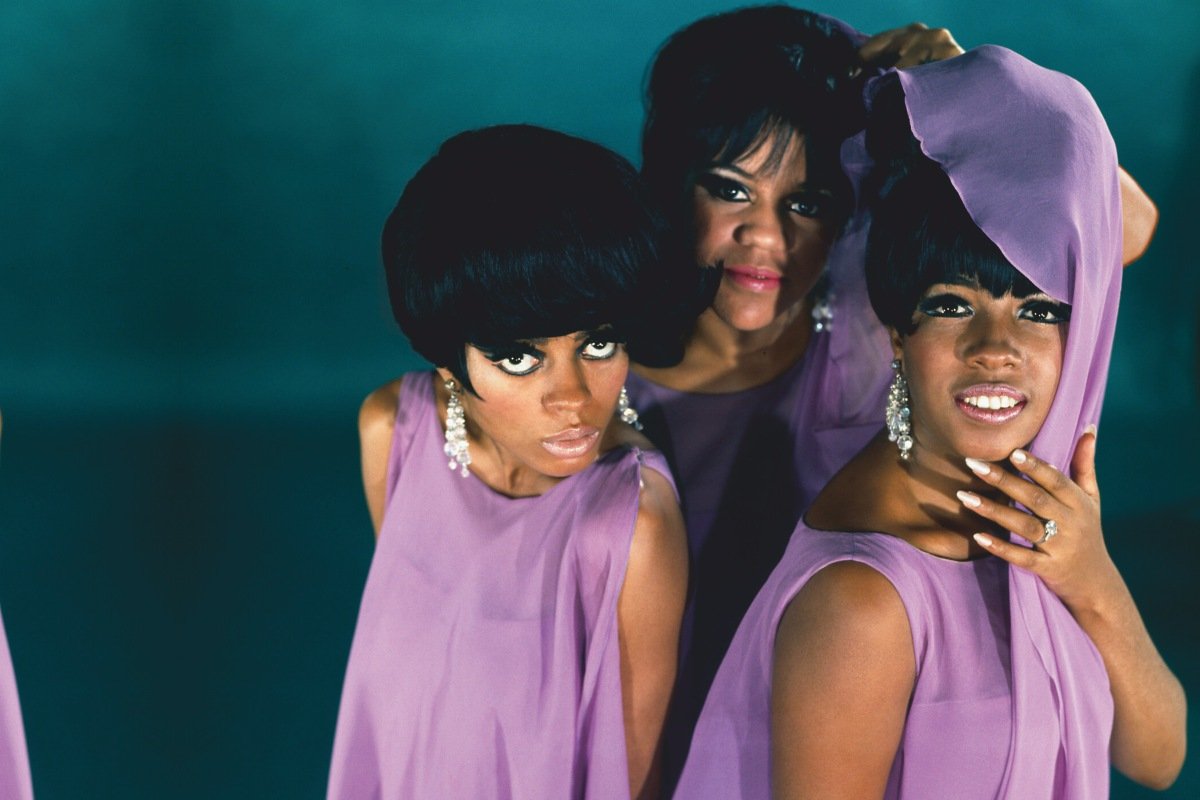In 1959, the Supremes were founded as the Primettes in Detroit, Michigan. It was Motown’s most commercially successful act and the most successful American vocal band consisting of 12 number-one singles on the Billboard Hot 100. The original members Florence Ballard, Mary Wilson, Diana Ross, and Betty McGlown were all from the Brewster-Douglass public housing project in Detroit. They incorporated the Primettes as the sister act to the Primes. Thereafter, in 1960, Barbara Martin substituted McGlown, and the group signed with Motown as the Supremes one year later. In 1962, Martin left the act and Ross, Ballard, and Wilson continued as a trio.
Having Ross as the lead singer and Holland–Dozier–Holland as the songwriting and production team, the Supremes accomplished mainstream success in the middle of the sixties. The Motown president Berry Gordy changed the name of the group to “Diana Ross and The Supremes” and included Cindy Birdsong in the place of Ballard in 1967. When Ross left the group to fulfill his dream of a solo career, the group gained its original name The Supremes.
Motown and Supremacy
The Supremes experienced a vital moment in their career by signing with Motown Records. Mostly addressed as “Hotsville, USA”, Motown was a powerhouse of talent which included acts like Stevie Wonder, The Temptations, Marvin Gaye, etc. In 1964, their first chart-topper, “Where Did Our Love Go” was released, which became a game changer as the infectious melody of the song and the angelic vocals of Ross made it an instant classic. Their music was a combination of pop and soul, hence known as the “Motown Sound”, reflected in their series of chart-topper “Baby Love”, “Stop! In the Name of Love”, and “You Can’t Harry Love”.
Empowerment and Civil Rights

The Supremes were more than just a musical sensation for their fans. They embodied resilience and empowerment. The group broke down barriers when racial segregation and discrimination were growing. The first all-female group was succeeding in a male-dominated industry and becoming popular. Furthermore, the music of the Supremes carried the message of social unity along with hope and love, which resonated in the Civil Rights Movement of the 1960s. They performed at events supporting racial equality and were an inspiration to many African Americans during this turbulent period in American history.
Impact on the Audience
The Supremes deliberately adopted a more glamorous image, encouraged by Motown chief Berry Gordy and Maxine Powell. Ross sang in a calmer and thinner voice as compared to her contemporaries and her vocal styling was matched by having all women embellish their femininity rather than duplicating the male groups. The Supremes appeared onstage with highlighted make-up and a high-fashion gown with wings. Moreover, they performed gracefully with a choreography by Cholly Atkins. The Supremes were told to “be prepared to perform before kings and queens.” Gordy wished for The Supremes to be equally appealing to black and white audiences, like other male groups.
The Supremes were international stars by 1965, who traveled around the world and became famous. They recorded songs for motion picture soundtracks after their initial number-one hits. The song was launched in the film “Beach Ball” and the group endorsed dozens of products, at one point having their bread brand. “I Hear a Symphony”, “You Can’t Harry Love”, and “You Keep Me Hanging On” were added to their list of hit songs. Consequently, the group released The Supremes A’ Go-Go, which appeared to be the first all-female group album to achieve a separate position on the US Billboard 200. They knocked the Beatles’ Revolver out of the top spot.
As The Supremes were famous among black as well as white audiences, at renowned supper clubs, for example, the Copacabana in New York, Gordy had the group performance. Furthermore, pop standards and Broadway were established in their repertoire in addition to their hit songs. Soon, it turned out to be the first black musical act to gain a remarkable and sustained crossover success.
What issues did the group face?
Every success story has some dark shades, and clearly, The Supremes are not an exception. It experienced tension due to recurring problems with Motown Records’ stable performers. According to some sources, Berry Gordy was focusing mainly on the Ross and it was quite unfair to other members of the group. Changing the name of the group escalated the rumors of a solo career of Ross and led to professional as well as personal damage to the group.

When Ross became the focus, Ballard started suffering from depression and developed an excessive drinking habit. She put on so much weight that she couldn’t comfortably wear many of her performance outfits on the stage. Subsequently, she pursued a solo career with ABC Records and was forced to deny solo contracts of Motown as a part of the settlement.
The Supremes in the 1970s
In January 1970, the Supremes performed at the Frontier Hotel in Las Vegas under the name ‘Diana Ross & The Supremes’, which was considered their last performance. One year later, the live recording of the performance was made public with the title, ‘Farewell’. At the event, Jean Terrell was announced as the replacement for Diana Ross and changed the name to ‘The Supremes’. “Right On” was the first album of the group without Ross and included Jean Terrel with Mary Wilson and Cindy Birdsong. “Floy Joy” was the group’s Top 20 hit single release written and produced by Smokey Robinson and “Automatically Sunshine” was followed after that.
Thereafter, it became the final Top 10 singles in the UK. Terrel shared the lead with Mary Wilson on both ‘Floy Joy’ and ‘Automatically Sunshine’. After recording the Fly-Joy album, Cindy Birdsong left the group and Lynda Laurence was introduced. Jimmy Webb started to produce the Supremes. The Stevie Wonder-led “Bad Weather” reached 87th rank on the US pop charts and 37th in the UK in early 1973. Laurence left the group to start her family hance, and Cindy was brought back.
In the UK and Japan, the Supremes remained a popular live act and continued touring overseas. However, the new recordings of the group were not as successful as their earlier ones. “He’s My Man” was a popular disco hit in 1975 on which Payne and Wilson shared lead vocals.
Many producers published a fiction work based upon the journey of the Supremes. The trio called ‘Sisters & the Sisters’ from New York appeared in the movie called ‘Sparkle’ was a true story of the group. Loosely based on the history of the Supremes, the Tony Award-winning musical ‘Dreamgirl’ appeared at the Imperial Theatre. It represents the all-female singing trio from Chicago who became music superstars.
Awards and Nominations
In the category of ‘Best Rhythm’, The Supremes were nominated twice for the Grammy Awards. However, it never won any awards in the competition. Thereafter, three of their songs were added to the ‘Grammy Hall of Fame’ which includes “Where Did Our Love Go” and “You Keep Me Hangin’On” (both 1999) and “Stop! In the Name of Love” (2001). In 2023, the group (Ross, Wilson, Ballard) was named one of eight recipients to receive a Grammy Lifetime Achievement Award at the 65th Annual Grammy Awards. The Supremes had a profound influence on black society and inspired black girls to achieve notable awards in music.

The Supremes Group fans were excited about the reunion and wanted them to perform live to remember the old days. In 1982, Motown reunited the group (Wilson, Birdsong, and Payne) and included them in recordings. However, Wilson refused to reunite, and the idea was scrapped. To perform “Someday We’ll Be Together” Ross joined Wilson and Birdsong and reunited with them. In 1976, with the death of Florence Ballard and Mary Wilson in 2021, there is no longer any possible reunion of the original classic lineup.
Legacy and Influence
The legacy of the Supremes is indelible, as their music is timeless and has given numerous hits to continue the grace of airwaves. The compositions like “My World Is Empty Without You” and “Someday We’ll Be Together” keep resonating with the international audience. The Supremes inspired future female artists like Destiny’s Child and TLC. They are a symbol of empowerment, resilience, and cultural progress, reaching beyond just the music industry.
Conclusion
The Supremes are integral to American cultural history because of their harmonious melodies, contributions to the Civil Rights Movement, and barrier-breaking achievements. Today, their music is entertaining old and new generations by cherishing the melody spread by the group. Moreover, the success story of the group serves as a testament to the power of talent, unity, and determination. The Supremes defined an era in music and inspired positive change.
Also read: Unfolding Maya Angelou’s Poetry, Life, and her Road to Fame








